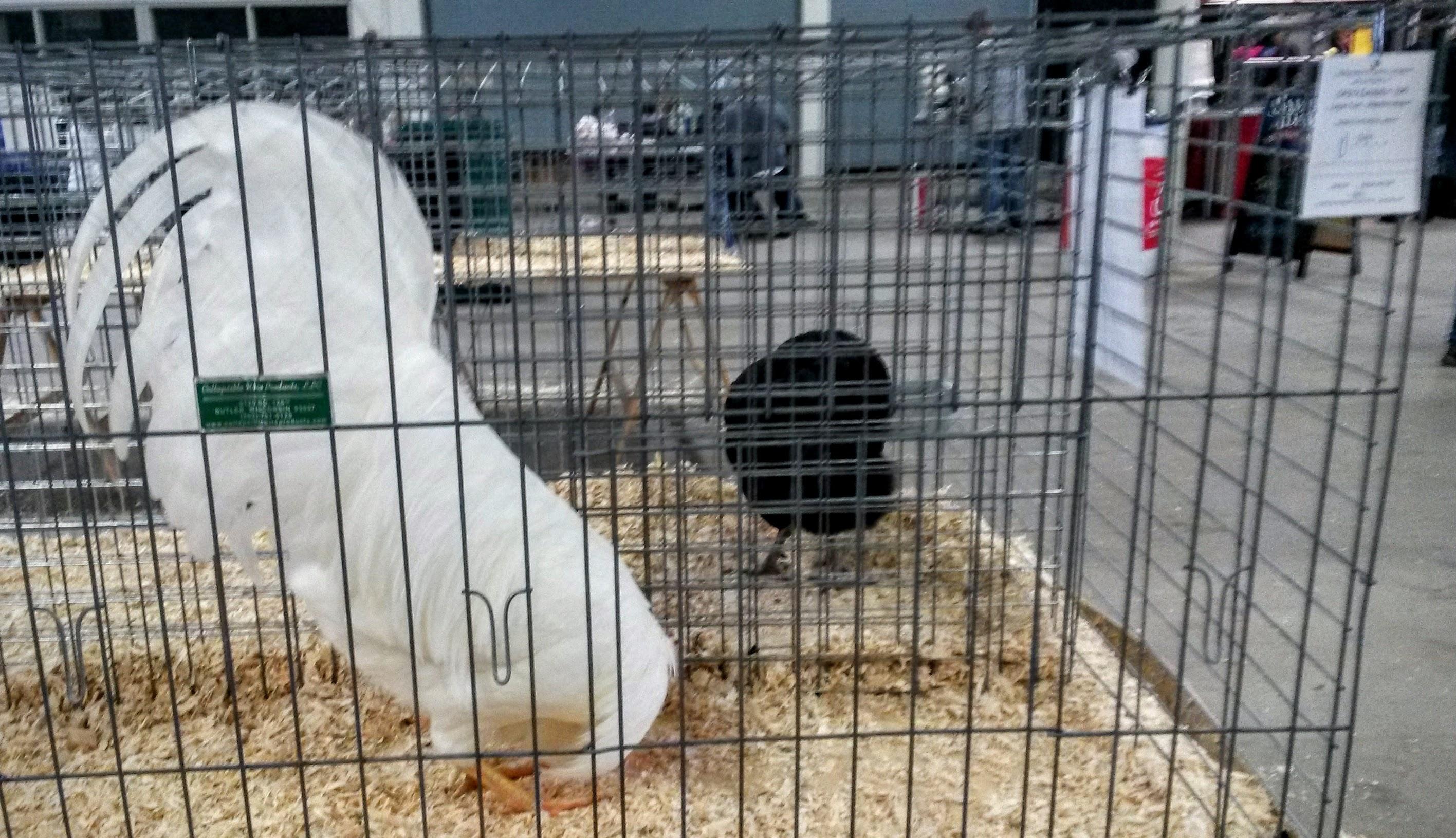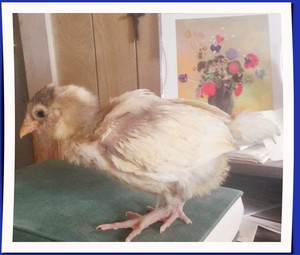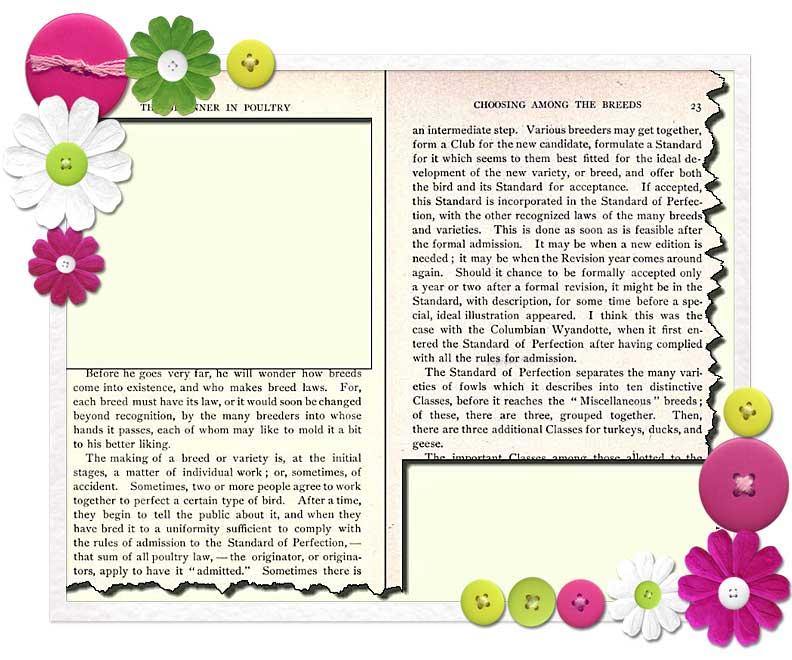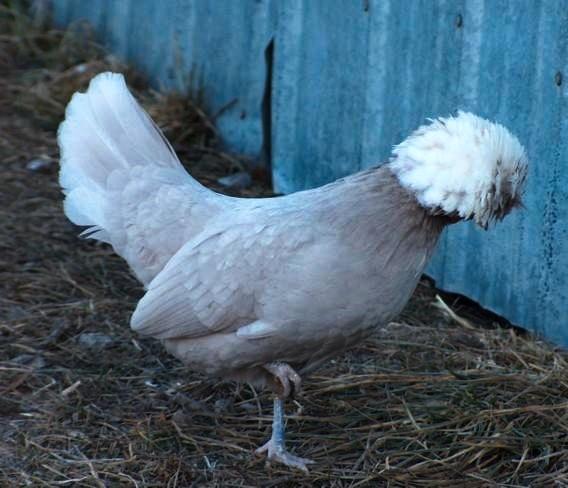21 Sep Wed 2016
Chicken rollatini is always in season
From Food & Wine, a green chicken dish.
- Season the chicken breasts with salt and pepper. Tightly roll them up lengthwise and secure with toothpicks at 1-inch intervals.
- In a large saucepan, combine the vinegar, 3/4 cup of water and a pinch of salt and bring to a gentle simmer. Add the chicken and cook over low heat until just white throughout, 10 to ?12 minutes. Transfer the chicken to a work surface and let cool slightly. Discard the toothpicks. Slice the chicken crosswise into 1-inch-thick rounds.
- In a large bowl, whisk the olive oil with the mixed herbs and season with salt and pepper. Add the chicken, turning to coat evenly in the herb oil. Let cool to room temperature, about 30 minutes. Cover and refrigerate for at least 2 hours or overnight. Bring to room temperature and serve with crusty bread.
16 Jul Sat 2016
The chantecler died
She was a great brood mother. Unfortunately, she had a black cap on her head, which I was told by the Club Founder, Mike Gilbert, was not APA accepted. Pity, I liked that look at lot; I think that was a mistake. Still that was the case, so what can you do; she never went a show room but stayed on the farm, and was happy.
This year she was in her glory. She would go around cluck and worry about her chicks, all buff Ameraucanas, and look after the 25 counting heads and making sure they were all there. Some of them got culled early on because they had crooked or scissor beaks. When I killed them, she would scream and look for them and then huddle the survivors under her broad wings for protection.
 |
| Cornish partridge female. My chantecler female with the black head was similar but the eyes were not as prominent and of course the comb was a cushion. |
The page attached is from the Livestock Conservancy Book, which is somewhat better than their website but not much. The partridge Chanteclers unlike the whites, are from Alberta. They are very broody.

The importance of a breeding plan

22 Jun Wed 2016
How a breed happens
This page is from C.S. Valentine's book, which I am currently reading. I trimmed out the nonessential paragraphs so you could focus on the topic at hand. Mr Valentine gives a very good account of how breeds "click" and come together -- and how no matter what anyone says, it is very much a combined effort. In some cases, like the Araucana, it was a decree and the APA just made the bird ignoring all the research previously done and giving it their own imprimatur. That alas has made the Araucana and Ameraucana a bit a problem from the Livestock Conservancy's pov as it does not recognize it's original South American heritage.
But they are exceptions.
Most breeds come together as he mentions and it takes a while for a breeder and his vision to coalesce and get a following. A good example is the American Salmon, which is supposed to be a rather de-feathered version of the Salmon Faverolle -- alas it is too plain for my tastes, but Gary Underwood is pursuing it with his merry band of 5 nonetheless. One thing rather interesting though of this bird is its dark coloured chocolate eggs...Marans watch out.
05 Jun Sun 2016
Victoria TX on Store bought chicks
This article on Hanselina is from 1984. Back then only Agway, the farm cooperative out of upper New York State, was the only way for most to buy chicks unless they knew a breeder who would sell them some. Now there are lots of hatcheries including your local Tractor Supply.
So what's the diff between hatcheries and breeder chicks? Quality for the most part. Most breeders are giving you chicks from their show line, so if you are good at culling and breed hard, eventually you can get a top flock. With hatcheries that will rarely if ever happen.
So how do you know a breeder from a hatchery?
Ask the seller, though some like Mt Healthy, Ideal, Hoffman and McMurray admit these are not show birds, but what you are getting is some stock to start with and replenish with show birds that you buy from breeders if you are interested in line improvement. Some people aren't, and they just want a pretty bird, but if you are interested in a good showable line that you will be keeping for years, make sure you know what you are getting from whom.
01 May Sun 2016
egg evaporation
Eggs lose from 13 to 16 per cent of their moisture during incubation are said to undergo normal evaporation. Infertile eggs oddly enough, evaporate faster than do those containing live germs; hence the candling or testing of the eggs is important, because keeping the humidity level is important.
I start checking the eggs on day #5. This day is the first day after the embryo has formed and is available for viewing. If the eggs are infertile at this point, typically this is a cockbirds problem. It’s important to know as soon as possible otherwise you can, and I have before I knew this, waste a lot of time to get a bad hatch.
The next time I check is on day #19 when i move them from the incubator to the hatcher.
Turning the eggs, manually
When we did not have an automatic egg turner, I turned the eggs twice a day. It’s a tough job so I picked a 12 hour interval i knew I would be awake. For me that was 10 am and 10 pm and so it wasn’t so bad.
Eggs undergoing incubation should be thoroly but carefully turned or shuffled at least twice daily from the second to the nineteenth day of incubation. Recent experiments have shown that it is not only desirable that the eggs be turned thruout the incubation period but very necessary that they be thoroly shuffled during the first ten or twelve days, in order that a high percentage of chicks dead in the shell be avoided.
I did do that too…shuffle them around, rolling them all over the Styrofoam making sure that the X’s were hidden 10 pm and visible at 10 am.
Eggs must be turned twice daily from the second to the nineteenth day of incubation with the early part of the incubation period is more vital than the latter part so far as the incubation factor of turning is concerned.
Whenever turning or certain amounts of turning are omitted the chicks that hatch are not as strong, do not fluff as well, and are more likely to have absorbed incompletely the remaining yolk on the nineteenth day.
Whenever turning or certain amounts of turning are omitted, there is a higher than normal loss of embryos as well the dreaded ” dead-in-shells “. Since I raise Araucanas, I am not looking to increase those odds.
The hen rotates her eggs about 180 times a day, moving and getting things settled, remember as her body, without feathers, is directly on the eggs, she can feels their movements and know when adjustments are needed. But why is turning the eggs during incubation so vital ? Well here are two reasons that have the most credence
- The yolk being lighter than the surrounding albumen it tends to rise, and, & unless the position of the egg is changed frequently, it will in time come in contact with the shell membranes.
- If allowed to remain in contact the germ is said to dry fast and finally die;
- Another idea is what is called exercise and its relation to nutrition and vitality.
- Here the prevalent thought is that “the embryo did not die from adhering to the shell membranes in the early part of the incubation period but rather lived until hatching time” and the movement deterred that.
30 Apr Sat 2016
Cystine is needed during molt
While a non-essential amino acid for man, molting birds need high cystine content for renewal of feathers because cystine is necessary for the production of keratin, the prime ingredient that constitutes feathers. Some medical researchers that it is a lack, or a biological block, of the absorption of cystine, that leads to men's hair loss.
Cystine is found in red peppers, garlic, onions, broccoli, brussels sprout, oats, granola, wheat germ, sprouted lentils & egg yolks, so one easy one to supply cystine is by feeding molting hens, their own, previously laid, eggs back. Cystine is the stable form of the chemical cysteine.
Tests conducted at the Nebraska Agricultural Experiment Station have shown that the endogenous nitrogen loss among nonmolting hens amounts to about 144 milligrams per kilogram of body weight, and among molting hens, 219 milligrams.
Evidently the molting hen breaks down tissue protein to supply the amino acid cystine for feather growth.
When 145 milligrams of cystine were added to the diet of the molting hen, the endogenous nitrogen loss was reduced to 137 milligrams. The feeding of cystine exerted a protein sparing out of proportion to its nitrogen content, thus indicating its value for feather growth.
Chicken Cages higher not deeper
An interesting study, done for battery caged layers, shows that when you buy one of your cages for transporting or showing or housing often injures the birds when you get them too deep. Instead the recommendation is to get them as shallow as possible. The reason seems to be that the shallower they are, the easier for the bird to get to the food trough and so presumably eat more. Since they are in caged because of environmental _stress_ of one type another, a fall off in their eating could be more harmful than helpful particularly as they have small gullets and systems and shock could cause a heart attack.
To be honest, I was scouting for something like as I have bought several types of cages in the past, some wire dog cages, other chicken oriented ones and I found that the very deep cages were problematic because if you put more than 2 cockerels in one, they will fight -- but if I used a higher but narrower one they didn't. I was wondering if this was just peculiar to my Ameraucanas or a general trend, but overall listening to the boys helped alleviate those problems.
Other findings are:
- When the battery cages 460 mm in depth (deep) were compared with 305 mm cages (shallow); the two shapes provided equal areas per bird but the 305mm was better.
- More eggs were produced per hen housed from 30 to 70 weeks in the shallow cages; this difference is significant.
- The pattern of feeding activity over the day was significantly more in the shallow cages; this pattern accords more closely with physiological requirements.
- Feather damage caused by pecking was slightly higher, but it became significantly more severe in the deep cages over a long period of time (70 weeks.)
- The proportion of cracked eggs (collected from 60 to 70 weeks) was significantly lower in shallow cages.
- In the shallow cages a higher proportion of birds was present in the front half; with the back almost being totally empty.
- It is suggested that some of the advantages conferred by the shallow cage may be related to the greater accessibility of the food trough.
29 Apr Fri 2016
Choosing grit for your chooks
Limestone grit is often used as a substitute for or in addition to oyster shells for laying hens. It is not quite so palatable as oyster shells to chickens, & so does not give as satisfactory an egg production. But if you are going to insist on limestone, then look for bright, shiny limestone grit which is eaten more readily than dull gray dolomitic limestone grit.
Many keep both oyster shells and limestone grit before the laying hens in separate shell hoppers. But honestly, it is better to allow laying hens free access to these sources of calcium than to incorporate into the feed.
A hen that lays 250 eggs in a year will need much more than one that lays 125 eggs.
Oyster shells contain 96 per cent OTOH or more calcium carbonate are used extensively as a source of calcium for eggshell formation. Crushed hen-size oyster shell grit is usually kept before the laying hens in separate shell hoppers.
A hen will eat two to four pounds of oyster shell or limestone grit in a year, depending on the number of eggs produced and the amount of calcium in the mash feed. When given free access to oyster shell and limestone grit, the hens consume much more oyster shell than limestone. Apparently the small amount of muscle adhering to the oyster shell adds to its palatability.
And then there are clam shells. They may be used as a substitute for oyster shells, but to be honest they are not quite as good.
27 Apr Wed 2016
Fish meal for chickens
Fish meal is the clean, dried, ground tissue of undercomposed whole fish or fish cuttings, sometimes both, with or without the extraction of part of the oil, and containing not more than 3 per cent salt. Some salt is beneficial to chooks, but after 3% it starts to accumulate in their livers and kidneys and starts to cause some health problems -- much like too much of salt would to ours. So keep the salt in the water, during the extremes of summer and winter, lower than that. I put a 1/4 of teaspoon in 3 gallons, alternating that with vinegar & plain water, so they get a variety of flavours but also don't overload on the salt.
Fish meals vary in composition and feeding value, so check for those from the white fish group which typically live near the sea or lake floor. These are chub, trout, lake bass,cod, pollack, whiting, grouper, hake, snapper & tilapia and for chooks they are superior to those made from dark oily fish that have oils throughout their flesh. Typical of the latter group are salmon, trout sardines, herring, tuna, mackerel and anchovies.
Fish meals made at low temperatures are superior to those processed at high temperatures as a general rule, and fish meals containing much of the viscera, as are obtainable from some fish canneries, are superior to meals made from whole fish.
The average fish meal has about the same composition and feeding value as meat scraps. In coastal regions, fish meal is as cheap or cheaper than meat scraps though of course the further inland you go, it becomes more expensive. White fish meal made by the low temperature or vacuum process contains protein of very high biological value and is a good source of vitamin G, riboflavin, which chicks need to avoid curled toe paralysis -- this is notable when a chook is born with toes that curl typically towards the body
The white fish meal also compares favorably with milk as an animal protein feedstuff so weighing the cost benefit could be pivotal in which to choose. I have gotten fish heads & tails from my local Wegman's fish department for about 3.99 a pound and typically make a soup out of it and give the fish, bones and all, to the chooks particularly during moult when they need the extra protein,
25 Apr Mon 2016
White leghorn cockbird
When I was at the Northeastern Congress Poultry show in Springfield Massachusetts back in January I took a lot of pictures. At the time I posted some but most I did not. This white leghorn male was one that caught my eye. I was taken aback by their tail feathers. I never realized how long and spectactular it was. I don't remember the exhibitor but it is a beauty.

Khaki Polish Tolbunt
I love the colour. I was surprised to learn that it is khaki, I thought it was porcelain. Well, anyways, I'm thinking of bringing that colour over to Ameraucanas, sans the crest of course. There are several problems in doing this: removing the crest, it's a dominant gene so that will take a while; getting the correct size (Tolbunts run a bit smaller than Ams) and finally getting the blue egg.
Chicken themes for your desktop
Ok, these set of themes is for Windows only , but otoh, there are some adorable chickens with hats. Interested? Go here.
Now, if you are not familiar with the Tumblr site, Chickens with hats, it is still around but pretty much defunct. She has gone onto to bigger, much bigger, things. So instead go and look at the calendar, over here.
Feeding chickens meat scraps or tankage
Meat scraps are widely used in poultry rations to supply protein and minerals. The amount used is generally between 5 and 15 per cent. Milk and fish meal are sometimes used in place of all or a part of the meat scraps in poultry rations but tankage is another kettle of fish.
Tankage is a packing house by-product somewhat similar to meat scraps and it generally contains 60 per cent protein, while meat scraps generally contain 50 per cent, so far sounds good, but tankage can be prepared by cooking under live steam or by the dry-rendering process. It's hard to know what the packing house did unless they label that. The latter process produces a product of higher nutritive value. "Stick," or the cooking water residue, and blood meal are often added to raise the protein content to 60 per cent, but these products are of low biological value and so tankage may be of lower nutritive value than meat scraps and as a rule should be avoided.



